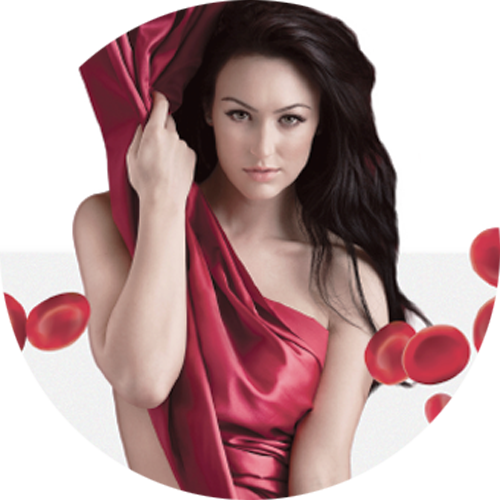
*Individual results vary, and are not guaranteed.
Platelet Rich Plasma (PRP)
Platelet Rich Plasma (PRP)
Platelet Rich Plasma (PRP) is a substance derived from your own blood that can be used to trigger a healing response. Platelets contain several growth factors that attract stem cells and increase rebuilding of tissues over several months.* It was initially developed in the 1970s and has been used since the mid-1990s to aid bone healing after spinal injury and soft tissue recovery following plastic surgery. More recently, PRP has become popular for healing sports injuries and for cosmetic procedures to increase collagen and improve overall skin health. Recent studies have also shown PRP treatment can stimulate stem cells for hair re-growth on the scalp.
*Individual results vary, and are not guaranteed.
Injection for Facial Rejuvenation
PRP Injection for Facial Rejuvenation
PRP is a natural alternative to synthetic fillers without the concern for allergic reactions. Platelets contain several growth factors that increase rebuilding of tissues over several months.* When injected into the face, the growth factors in PRP stimulate new collagen and blood vessel formation.
- New blood vessel formation improves the color and tone of the skin.
- New collagen formation in the dermis lifts the face back to a more youthful shape.
- The epidermis (outer most layers of your skin) appears smoother as the growth factors work to build up the dermis.
Facial
PRP Facial
The vampire facial involves topical application of the PRP combined with aeration of the skin with Micro Needling. The platelet-derived growth factors stimulate a healing response that reduces the appearance of fine lines and wrinkles while improving the skin’s tone and texture.
PRP naturally improves all aspects of skin health:
- Reduces fine lines and wrinkles
- Improves skin’s texture and tone
- Naturally increases collagen production
- Pore refinement
- Creates a natural glow
- Reduces acne scars
Stretch Mark and Scar Reduction
PRP with Micro Needling or targeted injection therapy can address a multitude of skin imperfections including hard-to-treat stretch marks. Areas commonly treated:
- Abdomen
- Thighs
- Buttocks
- Upper arms
- Any area of concern
Hair Restoration
PRP Hair Restoration
PRP Hair Restoration is a non-surgical solution for hair loss in both men and women. Platelet Rich Plasma contains growth factors that naturally stimulate the development of new hair follicles while improving the health of existing hair follicles.
What to expect:
First, a blood sample is obtained and processed to extract the Platelet Rich Plasma. A topical anesthetic is applied to numb the area being treated. The PRP is then administered with a fine needle in a series of injections on the scalp.
Mild swelling and redness can be expected 1-2 days following the treatment. It is recommended to avoid vigorous activity until the swelling has subsided. There is no other downtime following the procedure. New hair growth can be seen as early as 2 months, but is typically evident between 5-8 months and will continue to improve up to a year after treatment.* For best results, a series of 4 sessions is typically recommended. *Individual results vary, and are not guaranteed.
Musculoskeletal Injuries
PRP for Musculoskeletal Injuries
Platelet rich plasma injections can be used in the treatment of many musculoskeletal injuries including that of tendons, muscles and joints. It is especially beneficial for tendons, as they tend to heal more slowly due to poor blood supply. The utilization of advanced ultrasound technology may be used to guide the injection depending on the injury and injection site. Typically, 2 or more injections are required, separated by 4-6 weeks apart. This may vary depending on your injury.
Thank you, Dr. Sameer and the entire team.
The staff is friendly and they answered all my questions with ease and knowledge.
I have had Botox, fillers sculpture with excellent results. Along with IPL, B12 & Lipo shots, and the Diamond Tip treatments do wonders for my skin. Lastly the Laser no pain treatment for my neck
seems to help my neck look better.
That's a plus plus…
Doctor is amazing along with his entire staff. All are very professional and I continue to come back on a regular basis getting touch ups so I can look and feel my best. I'm very pleased with my results. I highly recommend this place. Give it a try you will not be sorry.
FAQ
PRP FAQ
What is PRP?
Platelet Rich Plasma (PRP) is a substance derived from your own blood that can be used to trigger a healing response. It was initially developed in the 1970s and has been used since the mid-1990s to aid bone healing after spinal injury and soft tissue recovery following plastic surgery. More recently, PRP has become popular for healing sports injuries and for cosmetic procedures to increase collagen and improve skin tone. Recent studies have also shown PRP treatment can stimulate stem cells for hair re-growth on the scalp.
What should I expect after PRP injection?
Following PRP treatment, an “achy” soreness may be felt near the area of injection. This soreness is a positive sign that a healing response has been set in motion. This effect typically lasts 1-2 days and gradually decreases as healing and tissue repair occurs. It is important that anti-inflammatory medications such as Ibuprofen, Naproxen and Aspirin be avoided following PRP treatments. These medicines may block the effects of the intended healing response facilitated by the injection itself. It is acceptable to use Tylenol and apply ice as needed. Most patients will be permitted to resume normal day-to-day activities and light exercise following injection. It is suggested that patients avoid strenuous lifting or high-level exercise for 1-2 days after the injection.
As with any injection, bruising may occur. It is best to plan PRP beauty treatments at least 7-10 days prior to any special events.
This treatment is not a “quick fix” and is designed to promote long-term tissue regeneration. The growth of new collagen may take up to six months and best results are seen with multiple treatments. Most patients see best results when they perform a series of 3 treatments at 4 to 6 week intervals.*
*Individual results vary, and are not guaranteed.
Is PRP Treatment Safe?
Research and clinical data show that PRP injections are extremely safe, with minimal risk for any adverse reaction or complication when administered by a fully trained physician. There is little chance for rejection or allergic reaction because the substance is autologous.
Who should not have PRP treatment?
To undergo PRP therapy, you should be in general good health and have realistic expectations of the outcome. Most people are suitable candidates for PRP therapy. Individuals with platelet dysfunction syndrome, critical thrombocytopenia, hypofibrinogenemia, hemodynamic instability, sepsis, acute and chronic infections and chronic liver pathology are not suitable candidates for PRP therapy. Those undergoing anti-coagulant therapy are also not suitable candidates. Smoking interferes with the growth factors and tissue healing. If you smoke, you will not experience the full benefit of PRP treatment.
How can I maximize the results of PRP?
There are several nutrients and cofactors necessary for optimal healing and health. The ideal way to get the nutrients you need for optimal health and a radiant complexion is eating a whole-foods diet with plenty of vegetables, fruits and quality sources of essential fatty acids and protein. Targeted vitamin, mineral and nutrient supplementation can also be beneficial, especially if you are under chronic stress or exposed to high levels of air pollution, second-hand smoke, or other harmful chemicals. Other factors that have an important impact on the health of your skin include adequate sleep, hydration, and exercise.
We provide state-of-the-art treatments and services to make your health and aesthetic goals a reality. As a team, it is our priority to help you achieve your dreams.
We offer a complimentary consultation for all of our services.










